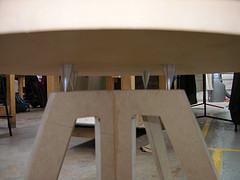 But this a relatively simple job requires certain skills and patience. A compilation of sophisticated artistic panel of individual tiles is better to entrust the professional mosaic. Countertop made of natural Stone preferably combined with an apron, made from the same material (or imitating his tiles). For this purpose, plates with a thickness of about 2 cm of solid rock: granite, basalt, marble. Granite – one of the hardest and solid rock, and its color palette consists of about a thousand shades, from pure black to almost white.
But this a relatively simple job requires certain skills and patience. A compilation of sophisticated artistic panel of individual tiles is better to entrust the professional mosaic. Countertop made of natural Stone preferably combined with an apron, made from the same material (or imitating his tiles). For this purpose, plates with a thickness of about 2 cm of solid rock: granite, basalt, marble. Granite – one of the hardest and solid rock, and its color palette consists of about a thousand shades, from pure black to almost white.
The most common and inexpensive is a gray-pink granite, but there are deposits of brown, yellow, orange, red and even blue stone. High strength, frost resistance and low water absorption makes it ideal for granite countertops and aprons. But Marble is less resistant to acids and has a higher than granite or basalt, water absorption due to microcracks. Together with the moisture it gets dirty, so that the working surfaces of marble is not the best choice. However, the property to absorb water depends on the quality Polishing – with polished slabs ideal moisture rolls down, not going inside. Not long ago, the market has a new decoration material, which also belong to a group of natural stone – litokeramika. Composite tile consists of two layers: natural marble thickness of 3-4 mm and 6-7 mm ceramic base. The geometry of the tiles is ideal, the basis of ceramics can be used when installing conventional tile adhesives, and as a result of to distinguish the finished surface of the plate tselnomramornoy almost impossible.
Litokeramika weighs only 18 kg / m, while the marble – 30 kg / sq.m. It is resistant to sudden temperature changes and has waterproofing properties. In Recently, designers, and manufacturers are actively using a combination of like with like (same material for countertops and kitchen apron). So countertop kitchen is complemented by laminated chipboard an apron made of MDF (thickness from 4 to 15 cm) coated with a film of the same color or pattern.